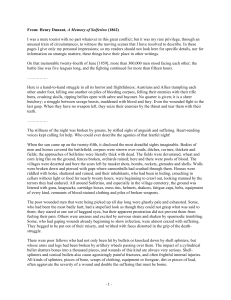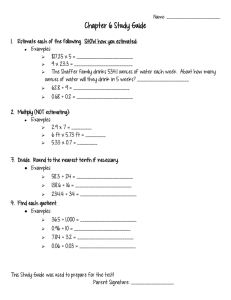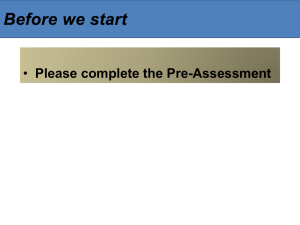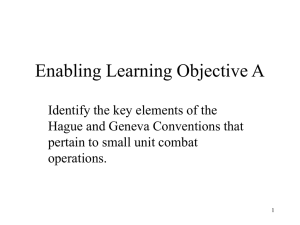'War and medicine'
advertisement
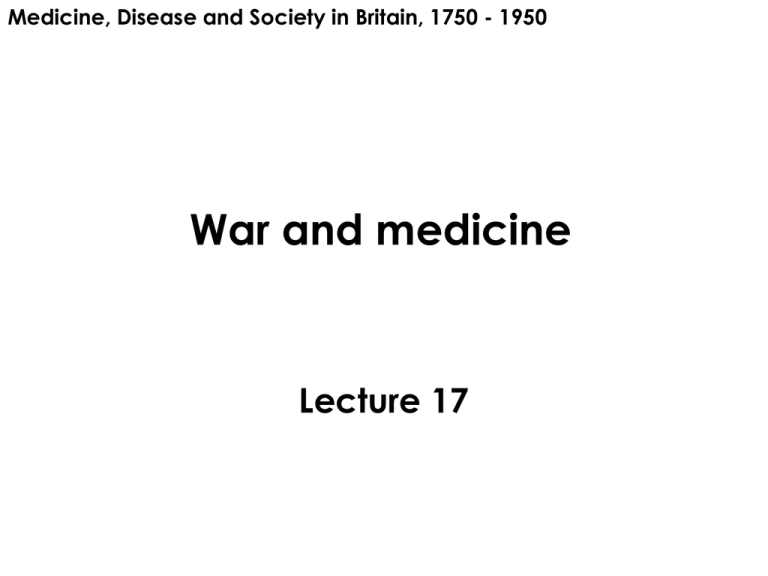
Medicine, Disease and Society in Britain, 1750 - 1950 War and medicine Lecture 17 Roger Cooter, ‘Medicine in war’, in Deborah Brunton (ed.), Medicine Transformed (Manchester, MUP), pp. 331-333: • The relations between war and medicine have only recently been seriously discussed by historians. • Early historians of medicine were more interested in public health, mental health care, hospitals and other features within what they perceived as the expanding social domain of medicine. Fear of endorsing ‘militarism’. • War also ‘unfashionable’ in 1970s and 1980s- shadow of Vietnam, war must relate to welfare. • It was only in the 1990s that historians of medicine begin to tackle the subject. War ceased to be seen as something separate from the rest of society and culture. IWW seen as the crucible of modernity; interest in Nazi medicine • Now includes, disablement and rehabilitation, nursing, shellshock, masculinity, civilian health Lecture Themes and Outline • The relations between medicine and war: positive and negative • Crimea, Boer, WW1 • Military medical services • New technologies and advances • Nursing • Civilian health ‘Progress through bloodshed’ • War provides a large, captive group of patients, and that doctors see many similar cases, need to be treated in emergency conditions and effectively- the ideal being that go back to the front to fight. • War stimulates medical research and must lead to significant advances. E.g. First World War introduced blood transfusions, hastened developments in reconstructive or plastic surgery, launched aviation medicine, and promoted research into wound-shock and management, shell-shock, gas-asphyxia, etc; while the 2nd World War saw introduction and mass production of ‘miracle drug’ penicillin and further developments in orthopaedics, treatment of burns and plastic surgery. • Represents a Whiggish, progressive and older view of medicine Problems with positive relationship • Reallocation of resources • Military medical innovations don’t translate into civilian life, e. g. Lind’s treatment of scurvy • Specialised treatment needed for wounds is sometimes so specific that it does not apply to peace-time health needs, e.g. amputations, gas attacks, gunshots • Often very chaotic in practice • Conditions are different in war and peace, e.g. during war, injuries in filthy trenches had dangers of infection, meaning surgeons more likely to amputate rather than to treat in a more conservative way • Role of a military surgeon is an ambiguous one. An officer meant to keep discipline as well as a humane medical practitioner Global estimates of the average annual military deaths in wars, by century: Century 17th 18th 19th 20th Military deaths (per million population per year) 19.0 18.8 10.8 183.2 (Data from Garfield and Neugent (1991, p. 689) Relative deaths: Disease and Wounds (Brunton (ed.) Medicine Transformed (2004) p.335). ‘000s Deaths from disease Napoleonic (1793- 1815) 195 wounds 8 ratio 24:1 (British only) Crimean (1854-66) 474 99 5:1 14 7.5 1.9:1 113 167.0 0.67:1 (French, British & Russian) Boer (1899-1902) (British only) First World War (British & empire only) James Lind (1716-94), A Treatise of the Scurvy (1753) • As sea voyages lengthened in C17 and C18, the impact increased e.g. over half died in Lord Anson’s voyage round the globe • 1747: experiment on the Salisbury- those fed oranges and lemons fit • 1795 naval authorities distributed lemon juice to sailors of salt rations > 6 weeks . Not introduced in Merchant navy until 1845. Witness Accounts • ‘Saw about two hundred wounded soldiers waiting to have their limbs amputated, while others were arriving every moment. It would be difficult to convey an idea of the frightful appearance of these men; they had been wounded on the 5th and this was the 7th; their limbs were swollen to an enormous size, and the smell from the gunshot wounds was dreadful...as many of them were wounded in the head as well as in the limbs, the ghastly countenances of these poor fellows presented a dismal sight...The surgeons ‘stripped to their shirts and bloody...to the right were arms and legs, flung here and there without distinction and the ground was dyed with blood’. (Peninsular Wars) • Sir Charles Bell, (1814) - reported at Waterloo. ‘All the decencies of performing surgical operations were soon neglected; while I amputated one’s man’s thigh there lay at one time thirteen all beseeching to be taken next. It was strange to see my clothes stiff with blood and my arms powerless with the exertion of using my knife’. Joan Lane, A Social History of Medicine (London: Routledge, 2001), p. 174: Photo of camp of the 3rd Grenadier Guards with the barracks, Scutari by James Robertson photo (1854). The early photographer James Robertson took some remarkable photographs at Scutari in 1854, while the British Army paused there on the way to the Crimea and encamped to the south of the Barrack Hospital. Poor physical state of recruits- 1917 • 1-fit for active duty • 2-some disability but suitable for garrison duty • 3-unfit – worked in auxiliary services- non combatant roles • 4- unfit (Parliamentary papers, 1917) H.R. Mackey, The RAMC on Active Service Military doctors: ambiguous roles Matthew Thompson, ‘Status, Manpower and Mental Fitness: Mental Deficiency in the First World War’ in Roger Cooter, Mark Harrison and Steve Sturdy (eds.), War, Medicine and Modernity (Thrupp: Sutton Publishing,1998) 149-66): • High proportion of officers among the shell-shocked indicates that diagnosis was a sign of patient-power (a way to escape the horrors of the trenches) as much as medical control • In a 1918 sample of officers only 6 per cent were sent back to duty. By contrast, among the lower ranks, 48 per cent were sent back to the front • Even if the war was a watershed in attitudes and standards of care, it was a watershed which was differentiated according to status, benefiting the neurotic but leaving a ghetto of neglect for the defective and the chronic and incurable mentally ill • The shell-shock-dominated story of First World War psychiatry – of new knowledge and more sympathetic attitudes inaugurating an era of mental hygiene – is flawed: it focuses too exclusively on high-status individuals; lower-status groups experienced very different fortunes Mobile bacteriological laboratory, 1912-13. Mobile labs such as this were used in the First World War to identify diseases and infections among sick and wounded soldiers. Henry Tonks was a surgeon who became an artist, returning to medical work during the First World War. These two pastel drawings by Tonks show a patient before and after plastic surgery. VAD Nurses on parade at a camp at Osborne during the First World War. Effects on Civilian Health (Winter, Titmuss) • Reduction in maternal and infant mortality – – – – – Female employment Better food distribution Improved services for mothers and babies Reduction in maternal and infant mortality Reduced alcoholism • Higher mortality for elderly – Stress • Increase in smoking & respiratory tb. Also dangers at workplace Carnegie Trust Report on Maternal and Child Welfare in 1917: ‘The value of population has never been appreciated as it is today, and regrets at the unheeded wastage of infant life in bygone years are as sincere as they are useless, a simple calculation shows that had the annual wastage of male infant life during the last 50 years been no greater than it is at present, at least 500,000 more men would have been available for the defence of the country today.’ With imports of food declining because of the U boat attacks on shipping and the advance of the German army across Europe , the British government set up a committee of nutritional experts to advise the War Cabinet on a strategic food policy. A typical ration book during World War Two. The committee issued a report with the effect that each person in Britain could easily survive on twelve ounces of bread, six ounces of vegetables, a pound of potatoes, two ounces of oatmeal, an ounce of fat, and six-tenths of a pint of milk per day, supplemented either by small amounts of cheese, pulses, meat, fish, sugar, eggs and dried fruit. Conclusion • Cooter’s ‘balance sheet’ of war and medicine • An existing abundant literature on medicine in wartime pays little attention to the wider context in which war was waged, or of the role of war in the making of modern society. Until very recently, this literature has been overwhelmingly dominated by practitionercentred accounts of how medicine has benefited from and been advanced by war. • While it is widely recognized that research into preventive and therapeutic medicine has often intensified during wartime, how did these transfer into civilian population? Complex. Pressing questions about the impact of the war on the aims, concerns and social configurations of medicine have been ignored in favour of simple and self-serving narratives of technical and organizational advancement. • Military medicine – a contradiction? Health of individual vs objectives of overall mission


